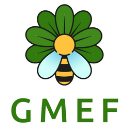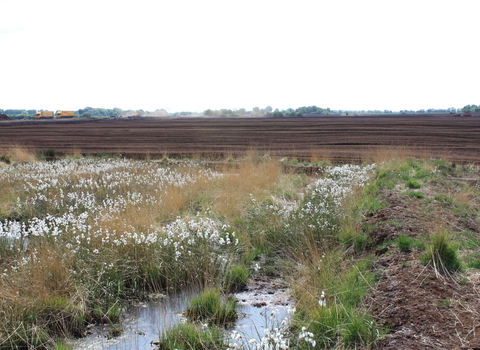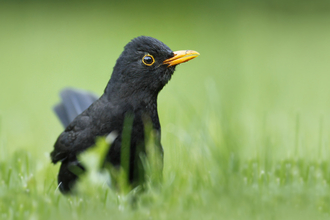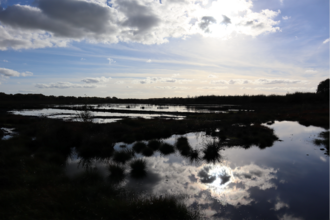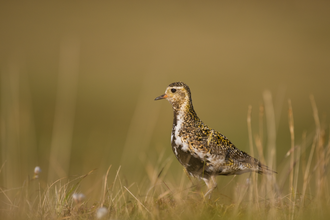PROJECT TITLE: Scaling Up Natural Capital Investment
LOCATION: Chat Moss, Salford
FUNDING: Awarded £100,000 from the Natural Environment Investment Readiness Fund
PARTNERS: Greater Manchester Combined Authority, The Wildlife Trust for Lancashire, Manchester and North Merseyside, Finance Earth, and Greater Manchester Environment Fund's Steering Group
Stimulating investment into our valuable peatland habitats
The Greater Manchester Environment Fund (GMEF) was established in 2020 to align funding and attract private investment to tackle urgent environmental challenges facing the city region. Our Investment Strategy and Overview informed how GMEF would work with partners and stakeholders to secure new investment, and included two investment models for Habitat Banks and Carbon Offsetting. In 2021, these models received £100,000 of funding from the Environment Agency to be tested.
This Natural Environment Investment Readiness Fund (NEIRF) project tested expansion opportunities for GMEF by developing two financing models based on Biodiversity Net Gain (BNG) and carbon income to lever investment into priority habitats to scale GMEF and realise Greater Manchester's Local Nature Recovery Strategy.
The project involved a cross-sectoral partnership between the Lancashire Wildlife Trust, Greater Manchester Combined Authority, Finance Earth and GMEF’s Steering Group. The partnership has assessed opportunities to deliver investment into a pilot site at Chat Moss in Salford to restore degraded agricultural land to vital lowland peatland habitat. The pilot conducted financial and ecological analysis to test and demonstrate income stacking approaches, inform the extension of the UK Peatland Code to lowland peat on agricultural land, and share learnings through GMEF to scale up investment approaches. GMEF has an important role in establishing a pipeline of regional BNG and carbon investment opportunities.
Our findings
The pilot found that both carbon and BNG have the potential to be viable income options to restore lowland peatland habitat. The sale of biodiversity units could generate around £800,000 of income for the 20 hectare pilot site over a 30 year period, with local demand projected at around 16 biodiversity units per year.
Alternatively, carbon income could generate approximately £2,000,000 for the site over a 50 year project lifetime, primarily through future sales of verified carbon units to the voluntary domestic market.
However, a number of barriers are currently blocking private investment into such sites, including:
- delays to the launch of the Peatland Code v2 to attract peatland carbon income to restore habitats on formerly agricultural land;
- delays to the land acquisition and management agreements for the pilot site; policy uncertainty around BNG implementation;
- lack of track record for peatland investments.
There are opportunities for public investment to overcome these barriers and kick-start a market for lowland peatlands, and these are being explored by the Lancashire Wildlife Trust.
During this project it became clear that there were wider barriers to progressing Biodiversity Net Gain, including:
- the ability to replicate and scale up needed resourcing;
- many people finding BNG overwhelming or confusing, with a lot of unknowns making it difficult to fully understand the process and resources required;
- although the pilot project in Salford (NEIRF Round 1) helped to define the process and make it clearer and streamlined, people were keen to see how this could be demonstrated on the ground;
- the pilot focussed on one habitat type and didn’t answer questions about other habitats or land in public ownership;
- there were a number of Local Authorities in Greater Manchester that were keen to develop new pilots but could not afford the resources to conduct baseline surveys and produce management plans. This would give other Local Authorities the confidence to take forward BNG.
Without unblocking these barriers there was the danger that BNG offsetting will be poorly managed, will not address priorities, will be undervalued particularly by long term management and hidden costs, and investment will go outside of Greater Manchester.
Next steps
BNG was increasingly seen as an opportunity to deliver on our commitment to our Local Nature Reserve Network Strategy and an application was submitted to Round 2 of NEIRF. GMEF secured Natural Environment Investment Readiness Fund 2 in July 2022 to:
- Build upon learning from NEIRF1 project.
- Work with several districts to focus on barriers to progressing BNG, overcoming challenges and sharing learning.
- Focus on 'back end' challenges – legal agreements, monitoring contracts, liabilities as opposed to just identification / preparation.
- Share learning amongst districts to help ensure BNG investment in Greater Manchester is maximised to help address identified funding gap.
If you would like more information on our Investment Models and services that are being developed please contact us at gmenvfund@lancswt.org.uk and our team will be in touch.
